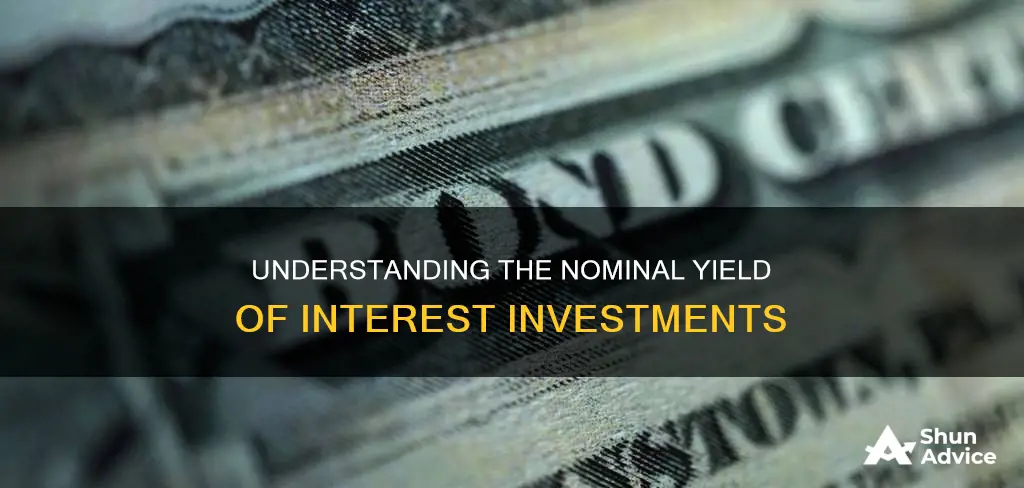
The nominal yield of an interest investment is the coupon rate on a bond. It is the interest rate that a bond issuer promises to pay to bondholders. The nominal yield is calculated by dividing the annual interest payments by the face value of the bond. This rate is usually fixed over the life of the bond, but it does not always represent the realised annual return of a bond due to market fluctuations in interest rates and their impact on bond prices.
| Characteristics | Values |
|---|---|
| Definition | The nominal yield is the coupon rate on a bond. It is the interest rate that a bond issuer will promise to pay to the bondholders. |
| Calculation | Nominal yield is calculated by dividing the annual interest payments by the face value of the bond. |
| Coupon rate | The nominal yield is also referred to as the coupon rate of a fixed income security. |
| Annual percentage | The nominal yield is an annual percentage, but it does not necessarily represent the realised annual return of a bond. |
| Inflation | The nominal rate equals the perceived rate of inflation plus the real interest rate. |
| Current yield | The nominal yield does not always represent the current yield because it's a percentage based on the bond's par value, and not the actual price that was paid to buy that bond. |
What You'll Learn
- The nominal yield is the coupon rate on a bond
- The nominal yield is the interest rate that the bond issuer promises to pay bond purchasers
- The nominal yield is an annual percentage
- The nominal yield is calculated by dividing the annual interest payments by the face value of the bond
- The nominal rate equals the perceived rate of inflation plus the real interest rate

The nominal yield is the coupon rate on a bond
The nominal yield does not always represent the current yield because it is a percentage based on the bond's par value, and not the actual price paid to buy the bond. Buyers who pay a premium that is more than the face value for a given bond will receive a lower actual rate of return than the nominal yield, while investors who pay a discount that is less than the face value will receive a higher actual rate of return.
The nominal rate equals the perceived rate of inflation plus the real interest rate. At the time a bond is underwritten, the current rate of inflation is taken into consideration when establishing the coupon rate of a bond. Thus, higher annual rates of inflation push nominal yield upward.
Understanding Investment Mathematics: Compound Interest Explained
You may want to see also

The nominal yield is the interest rate that the bond issuer promises to pay bond purchasers
The nominal yield is the coupon rate on a bond. In other words, it is the interest rate that the bond issuer promises to pay bond purchasers. This rate is fixed and applies for the life of the bond. It is calculated by dividing the annual interest payments by the face value of the bond. For example, a bond with a face value of $1,000 that pays the bondholder $50 in interest payments annually would have a nominal yield of 5%.
The nominal yield does not always represent the current yield because it is a percentage based on the bond's par value, not the actual price paid for the bond. Buyers who pay a premium that is more than the face value for a given bond will receive a lower actual rate of return (RoR) than the nominal yield, while investors who pay a discount that is less than the face value will receive a higher actual rate of return.
The nominal rate equals the perceived rate of inflation plus the real interest rate. At the time a bond is underwritten, the current rate of inflation is taken into consideration when establishing the coupon rate of a bond. Thus, higher annual rates of inflation push nominal yield upward. As interest rates rise and fall, bond prices move inversely to rates, creating higher or lower nominal yields.
Interest Rates: Impact on Pending Investments
You may want to see also

The nominal yield is an annual percentage
The nominal yield does not always represent the current yield because it is a percentage based on the bond's par value, and not the actual price that was paid to buy that bond. Buyers who pay a premium that is more than the face value for a given bond will receive a lower actual rate of return (RoR) than the nominal yield, while investors who pay a discount that is less than the face value will receive a higher actual rate of return.
The nominal yield is also influenced by the rate of inflation. The nominal rate equals the perceived rate of inflation plus the real interest rate. Higher annual rates of inflation push nominal yield upward. For example, three-month Treasury bills peaked in the secondary market at a yield of 15.49% in December 1980, compared to 1.5% in December 2019.
Maximizing Returns: Choosing the Right Investment Interest Rates
You may want to see also

The nominal yield is calculated by dividing the annual interest payments by the face value of the bond
The nominal yield is the coupon rate on a bond, which is the interest rate that the bond issuer promises to pay bond purchasers. This rate is fixed and applies to the life of the bond. It is calculated by dividing the annual interest payments by the face value of the bond. For example, a bond with a face value of $1,000 that pays the bondholder $50 in interest payments annually would have a nominal yield of 5% (50/1000).
The nominal yield does not always represent the current yield because it is a percentage based on the bond's par value, not the actual price paid to buy the bond. Buyers who pay a premium that is more than the face value for a given bond will receive a lower actual rate of return (RoR) than the nominal yield, while investors who pay a discount that is less than the face value will receive a higher actual rate of return.
The calculation of a nominal yield in annual terms is done by adding all the bond payments made during the year. If there is one annual payment, then that is it. If it is a semi-annual or quarterly paying bond, you must add all of the payments for the year. Then, divide the total amount of annual interest payments by the face or par value of the bond.
The nominal rate equals the perceived rate of inflation plus the real interest rate. At the time a bond is underwritten, the current rate of inflation is taken into consideration when establishing the coupon rate of a bond. Thus, higher annual rates of inflation push nominal yield upward.
Margin Interest Deduction: A Smart Investment Strategy?
You may want to see also

The nominal rate equals the perceived rate of inflation plus the real interest rate
The nominal yield is the coupon rate on a bond. It is the interest rate that a bond issuer will promise to pay to the bondholders. This rate is usually fixed over the life of the bond.
The nominal yield is calculated by dividing the annual interest payments by the face value of the bond. It is also referred to as the coupon rate of a fixed-income security. The calculation of a nominal yield in annual terms is done by adding all the bond payments made during the year. If there is one annual payment, then that is it. If it is a semi-annual or quarterly paying bond, you must add all of the payments for the year. Then, divide the total amount of annual interest payments by the face or par value of the bond.
The nominal yield does not always represent the current yield because it's a percentage based on the bond's par value, and not the actual price that was paid to buy that bond. Buyers who pay a premium that's more than the face value for a given bond will receive a lower actual rate of return (RoR) than the nominal yield, while investors who pay a discount that's less than the face value will receive a higher actual rate of return.
Savings or Investments: Which Offers Lower Interest Rates?
You may want to see also
Frequently asked questions
The nominal yield is the coupon rate on a bond. It is the interest rate that the bond issuer promises to pay to the bond purchasers. This rate is usually fixed over the life of the bond.
The nominal yield is calculated by dividing the annual interest payments by the face value of the bond. If there is one annual payment, then that is it. If it is a semi-annual or quarterly paying bond, you must add all of the payments for the year.
The nominal yield does not always represent the current yield because it is a percentage based on the bond's par value, and not the actual price that was paid to buy that bond. Buyers who pay a premium that is more than the face value for a given bond will receive a lower actual rate of return than the nominal yield.
The nominal rate equals the perceived rate of inflation plus the real interest rate. At the time a bond is underwritten, the current rate of inflation is taken into consideration when establishing the coupon rate of a bond. Thus, higher annual rates of inflation push nominal yield upward.







